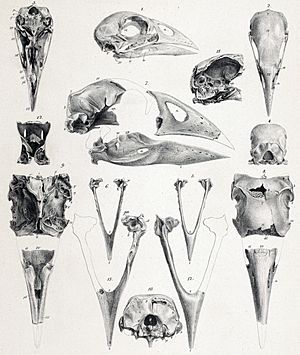North Island takahē facts for kids
Quick facts for kids North Island takahē |
|
|---|---|
 |
|
| Fossil cranial remains of P. mantelli (7-13) compared to those of a smaller, extant member of Porphyrio | |
| Conservation status | |
| Scientific classification | |
| Genus: |
Porphyrio
|
| Species: |
mantelli
|
 |
|
| Locations where fossils have been found | |
The North Island takahē or mōho (Porphyrio mantelli) was a large, flightless bird that lived in the North Island of New Zealand. It was a type of rail, a family of birds that includes coots and moorhens. Sadly, this unique bird is now extinct.
Scientists know about the North Island takahē from old bones and fossils found at different archaeological sites. It was even bigger than its cousin, the South Island takahē, which is still alive today but endangered. If the North Island takahē had survived until the 1890s, it would have been the largest rail bird known in recent history.
Contents
What was the North Island Takahē?
The North Island takahē was a very large bird that could not fly. Its scientific name, Porphyrio mantelli, was given to it in 1848. It was also known by its Māori name, mōho. This bird was a true giant among rails. It was even larger than the South Island takahē, which is already a big bird.
Where did the North Island Takahē live?
This bird lived only on the North Island of New Zealand. Its habitat likely included grasslands and possibly forest edges. Most of what we know about where it lived comes from finding its bones in ancient sites.
Why did the North Island Takahē disappear?
The main reasons for the North Island takahē's extinction are linked to changes in its environment and human activity.
- Habitat Changes: Over thousands of years, forests started to grow more into the open grasslands where the takahē lived. This reduced the amount of space available for the birds.
- Hunting: The Māori, who were the first humans to settle in New Zealand, also hunted the takahē. This hunting played a big part in the bird's decline.
For a long time, people thought the North Island takahē was the same species as the South Island takahē (Porphyrio hochstetteri). However, in 1996, a scientist named Trewick showed that they were actually two different species. This research suggested that both types of takahē evolved separately from different flying ancestors. This means they became flightless on their own, rather than one evolving from the other.
Who was Walter Mantell?
The scientific name of the North Island takahē, Porphyrio mantelli, honors a person named Walter Mantell. He was a naturalist and a civil servant. Naturalists are people who study nature, including plants and animals.
See also
In Spanish: Calamón takahe de la Isla Norte para niños


